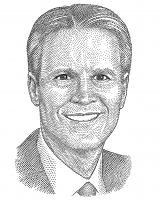
David B. Hellmann,
M.D., M.A.C.P.
In Ridley Scott’s new movie, “The Martian,” there’s a wonderful scene in which astronaut Mark Watney, stranded on Mars, chooses to overcome his situation instead of give in, and he does it through faith, sheer grit, and because he’s determined to “science” the heck out of it, to work the problem. He also manages to survive because he’s got a lot of people all over planet Earth working just as hard to meet every new and difficult challenge he must face.
This issue of Breakthrough has the same “right stuff” – to borrow from another space movie. We’ve got investigators working to science the heck out of some pretty tough problems: lung cancer, Lyme disease, and age-related illness. The science they’re doing is creative, and it’s collaborative, because these are problems that need the expertise of people in different disciplines, and it all starts and ends with our patients.
But science can’t do everything. Our motto, “Medicine is a Public Trust,” begins with patients, too, and our first job as doctors is to care, and to notice things. For instance, we have long noticed that the people in our immediate neighborhoods around Johns Hopkins Bayview and Johns Hopkins Hospital don’t live as long as the people who live in more affluent neighborhoods further out in the suburbs. In fact, people in neighborhoods like Roland Park or Ruxton live 20 years longer than people who live right here, a block or two away from us. There are three major health causes for this: heart disease, cancer, and HIV/AIDS. (Unfortunately, another major cause of death is not health-related but a symptom of a violent culture: homicide.)
We can’t help noticing it, we can’t help thinking that this isn’t right, and we believe that we are uniquely able to do something to help. The CIM’s Five and Ten Initiative proposes that Johns Hopkins Bayview and its University partners focus their efforts and resources to increase the longevity of the residents in our neighborhood by five years over the next decade. We will be talking more about this in future issues of Breakthrough, but I wanted you to know that this is in the works. For more on how and what the CIM is doing, see the story on Page 21 about our recent retreat.
Other exciting news: Our Aliki Initiative is expanding to become the CIM Good Doctor Initiative, and it is growing to include nursing students and a nurse Attending. This is a groundbreaker for medical education, and it’s long overdue. Nurses and doctors work together, and yet they learn separately – nursing students with nurses and medical students with doctors (see story on Page 12). Speaking of excellent clinicians, there’s a nice story about one of our Miller-Coulson Academy members, told by a medical student (see Page 16).
And finally, we are celebrating quitters. In the case of cigarette smoking, being a quitter is a very good thing, and a wildly creative new program, a collaboration between our Center for Behavior and Health and the Maryland Institute College of Art (MICA) is embracing the fact that for many people, it takes several attempts before they can kick the habit for good.
These are just a few of our many reasons to celebrate in this holiday season.

Aliki Perroti Professor of Medicine;
Vice Dean, Johns Hopkins Bayview Medical Center;
Chairman, Department of Medicine